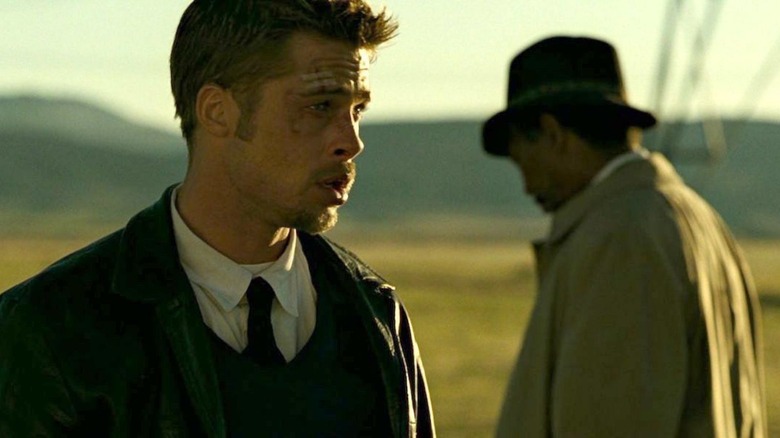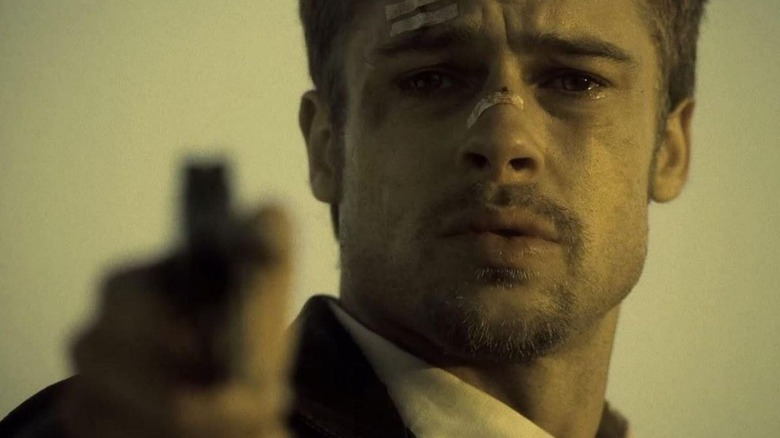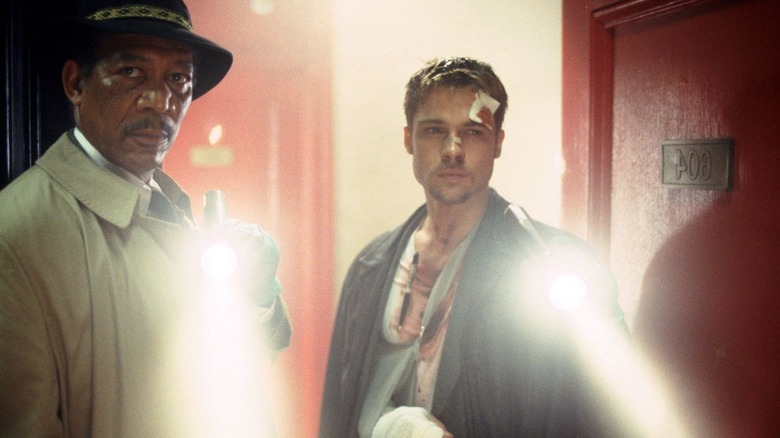Brad Pitt Did Everything In His Power To Keep Seven's Ending Intact
When talking about the best movies and the best movie endings of all time, David Fincher's "Seven" (or "Se7en," if you prefer) is right up there. It has been 27 years since the film was released in theaters worldwide, but just because all that time has passed, it doesn't mean our sentiments toward the film's unbelievably spooky ending have changed.
In "Seven," director David Fincher lets viewers experience the ultimate serial killer movie. The killer commits atrocities that are hard to describe, with a purpose that is laced with unimaginable evil. It also works as a horror movie, because among the film's many terror-inducing scenes, including a dead man face-down in a spaghetti bowl, blood-written messages, and a woman knifed to death, the scariest remains the unseen. It's hard to overlook just how brutal the ending of "Seven" was. It abandoned expectations and convention, only allowing viewers to discover what was inside that box through the dialogue and countenance of its characters. It turns out Brad Pitt fought hard to keep the film's ending intact — he knew it'd be more impactful if we didn't see the unspeakable.
What's in the box?
If you don't remember the ending of "Seven" too well, allow me to refresh your memory. After catching John Doe (Kevin Spacey), the killer who had been choosing his victims based on the seven deadly sins, detectives William Somerset and David Mills (Morgan Freeman and Brad Pitt) learn that one of his last two victims is Tracy (Gwyneth Paltrow), the latter's pregnant wife.
Unlike his other victims, Doe doesn't leave Tracy's body somewhere for her detective husband to find. He brings her (well, technically, her head) to him in a box, just when Mills thinks he has the upper hand. The two detectives, utterly distraught, are unable to come to terms with Doe's crime and the extent of its depravity. Mills eventually shoots Doe in absolute horror — he doesn't do the right thing as his colleague persuades him to. He merely gives a reaction.
The leading reason why the scene is so unsettling is we don't see Tracy's head; we envision it. Pitt wanted the movie's ending to evoke emotion in the viewer and fought tooth and nail to make sure Tracy's head stayed in the box and wasn't revealed to the viewers.
In fact, Pitt only agreed to sign on for the film under one condition, making it permanent in his contract. "I said, 'I will do it on one condition — the head stays in the box. Put in the contract that the head stays in the box,'" the actor explained to Entertainment Weekly in 2011.
It wasn't the only condition
Evidently, Brad Pitt wanted the ending of "Seven" to be frightening without viewers having to experience it. David Fincher had several ideas about the film's haunting conclusion, but Pitt was settled on one. He made sure the severed head remained in the box and that his character killed John Doe. Here's what he said during his EW interview:
"Actually, there was a second thing, too: 'He's got to shoot the killer in the end. He doesn't do the "right" thing, he does the thing of passion.' Those two things are in the contract. Cut to: 'Se7en' has been put together, and they've tested it. They go, 'You know, he would be much more heroic if he didn't shoot John Doe — and it's too unsettling with the head in the box. We think maybe if it was the dog's head in the box ...'"
While the possibility of the dog's head being in the box is pretty tragic, it's much, much worse to imagine a human — Mills' pregnant wife, at that — losing her life in such a violent manner. Ever since the film was released, its twisted turn of events and the harrowing ending have cemented "Seven" as an incredible addition to the world of neo-noir crime cinema.


